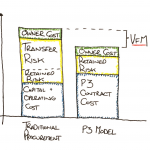Residential property tax has traditionally been based on the individual market value of each property year after year. While this method is widely used across Canada and considered to be an equitable tax system, the Provincial Government of Nova Scotia changed the tax system in 2005 due to growing concern over rapidly rising property taxes across the province.
The Capped Assessment Program (CAP) was implemented by the Provincial Government in 2005 (and revised in 2008) to protect citizens from “sudden and dramatic increases in property assessments”. Rather than taxing a home on its market value, municipalities are now required to “CAP” tax assessment increases to inflation – tied to the Nova Scotia Consumer Price Index (CPI). While the intent of the legislation was to protect homeowners from “sudden and dramatic increases” on their property tax, concerns over unintended consequences like affordability, equity and the overall credibility of the system (over the long run) have emerged.
Advantages
While homeowners generally benefit from an increase in home equity, year after year, they can only realize this benefit when the property is sold. During the time of ownership, they may not receive an equal increase in income (and in some cases, may even experience a decrease in income) needed to offset the year after year rise in residential property tax under the market value system. To its credit, the CAP does provide homeowners with increased predictability and insulates them from the “sudden and dramatic increases” previously observed.
From the regulatory side, the market value system has greater variation in individual property values each year. Generally, the stronger the real estate market, the greater the variation observed. This variation increases the administrative complexity of the property assessment process for municipal governments each year. Under the CAP, this administrative burden is reduced, resulting in cost savings.
Disadvantages
The disadvantages of the CAP system can be grouped into four broad categories: benefits are only realized in the short-term, the policy is inconsistently applied, social equity is reduced, and real estate market growth is slowed – all resulting in reduced economic growth over the long-term.
Short-Termism
The CAP has made property taxes more stable and predictable for many homeowners, but only in the short-term. This stability and predictability only appears to last while a homeowner remains in their home. Growing evidence is suggesting that, once a homeowner sells or renovates their property, the tax bill can increase dramatically, quickly wiping out previous tax savings.
The Halifax Regional Municipality (HRM) has reviewed taxation data to determine what happens when homeowners sell their home and purchase a new house. The data showed that 57% of individuals did save taxes; however, once they sold their homes and purchased a new home, instead of saving an average of $50 per year over the five years prior to sale, they were now paying an extra $280 per year. The net effect essentially negated their entire savings from the previous five years, in a single year.
While the CAP often appears to benefit individual homeowners, it does so only as long as they remain in their home. Once they switch homes or renovate, their tax is reset to market value and previous savings are quickly lost. As a result, over the entire seven-year period of the HRM study, nearly 70% of the homeowners paid higher taxes due to the CAP.
Inconsistency
The policy has also induced broad unintended consequences for taxpayers and for the economy, leading to dramatic shifts in property taxation. While almost 60% of single-family homes in the HRM have benefitted from reduced taxation, more than 25% of single-family capped homes pay higher taxes than under the traditional market value system. There are even instances of individuals downsizing to a smaller home yet paying higher taxes. In addition, those who are not eligible for the CAP have no access to the stability and predictability. Residential property taxation has become extremely inconsistent, diminishing the credibility of the property tax system.
Social Equity
While the majority of single-family homes are capped, most apartments are uncapped. Because of this, the impact of the CAP has been a shift in taxation – away from single family homes toward apartment rentals. An apartment building’s tax bill is paid by the landlord and passed on to tenants through their monthly rent. Although the average single-family home in the HRM saved $53 due to the CAP, average taxation on an individual apartment unit was $118 higher due to the CAP.
By shifted higher taxes onto apartment buildings, the CAP is also making it more difficult for renters to purchase their first home. As the majority of low-income individuals and young adults in urban centres reside in apartments, this inequitable taxation from the CAP disproportionally hurts low-income individuals and young people – increasing the cost of living and hindering their ability to enter the real estate market as new homeowners.
Market Impacts
Because the CAP increases property taxes on new homes and existing homes that sell or renovate, some individuals are delaying home purchases or renovations due to these higher property taxes. The CAP appears to negatively impact about 20% of homeowners, especially lower income homeowners facing increased difficulty moving, as they would lose the value of their CAP and see increased property taxes in a new home. In the five years from 2012 to 2016, taxes in the HRM have (on average) been 12% to 20% higher for home buyers due to the CAP. Because it distorts the value of new versus existing homes, it is viewed as poor or disabling tax policy.
A fundamental principle of property assessment holds that properties should be uniformly assessed – meaning, homes with comparable market values should be assessed at the same value. This goes back to the issue of consistency. If not uniformly assessed, individuals are being taxed using inconsistent approaches which leads to distorted taxation. This policy effect encourages taxpayers to modify their economic behaviour and act in a way that they normally would not. In the case of the CAP, the concern is that individuals will hesitate to buy, sell or renovate homes for fear of losing their CAP value and see their taxes rise. A survey of homeowners by the Canadian Revenue Agency in 2014 found that about 20% of homeowners could be putting off the purchase of a house, due to the CAP – causing a slow-down in the real estate market.
A policy induced slow-down in the real estate market negatively affects the ability of individuals to buy and sell homes, but it also reduces overall employment. Any slow-down in the real estate market impacts not only buyers and sellers but has economic impacts across the Province – affecting the construction sector (among others) and negatively impacts employment, income and economic growth across the province and region. It also creates a disincentive for homeowners to renovate. This reduces the ability of Nova Scotians to capitalize on residential energy efficiency upgrades needed to reduce carbon emissions in the residential sector. By its very nature, the CAP places higher taxes on those economic activities that society normally tries to encourage and has become a tax on economic growth.
Literature Cited
Chronicle Herald (2019) Property tax cap favours Nova Scotia’s wealthy. [Accessed on Feb 9, 2020] Available from: https://www.thechronicleherald.ca/business/local-business/property-tax-cap-favours-nova-scotias-wealthy-372974/
Halifax Regional Council (2017) The Capped Assessment Program in the Halifax Region. [Accessed on Feb 10, 2020] Available from: https://www.halifax.ca/sites/default/files/documents/city-hall/regional-council/171031cow3.pdf
NSFM (2020) Nova Scotia Federation of Municipalities Proposal for phasing out the Capped Assessment Program (CAP). [Accessed on Feb 10, 2020] Available from: https://www.nsfm.ca/?option=com_fileman&view=file&routed=1&name=Nova%20Scotia%20Federation%20of%20Municipalities%20(NSFM)%20CAP%20Proposal%20-%2022%20Jan%202020.pdf&folder=&container=fileman-files






Dave Sawdon
July 13, 2025 — 2:23 am
Is there an update on the CAP? This is affecting rental and new homeowners much more since 2020.